"I have a great feeling of a great
victory. Anyone who dares
even imply that we did not achieve a great victory obviously
doesn't know what the hell
he's talking about."
General
Norman Schwarzkopf




On the morning of August 2, 1990
the mechanized infantry, armor, and tank units of the Iraqi Republican Guard invaded Kuwait and seized control of that country.
The invasion triggered a United States response, Operation DESERT SHIELD, to deter any invasion of Kuwait's oil rich neighbor,
Saudi Arabia. On August 7, deployment of U.S. forces began. United Nations Security Council Resolutions 660 and 662 condemned
Iraq's invasion and annexation and called for the immediate and unconditional withdrawal of Iraqi forces. On August 20 President
Bush signed National Security Directive 45, "U.S. Policy in Response to the Iraqi Invasion of Kuwait," outlining U.S. objectives
- which included the "immediate, complete, and unconditional withdrawal of all Iraqi forces from Kuwait," and the "restoration
of Kuwait's legitimate government to replace the puppet regime installed by Iraq."


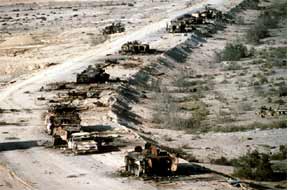


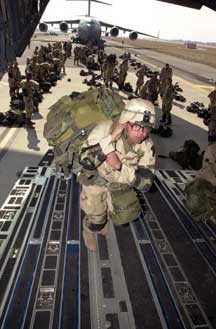
By the end of September, there were nearly 200,000 American
forces in Saudi Arabia - enough to successfully defend any Iraqi attack. The question remained, however, how to remove Iraqi
forces from Kuwait. The initial plan called for a direct offensive aimed at Kuwait City; but Schwarzkopf and other American
commanders thought that too risky against heavily-armed, well-entrenched Iraqis. Instead, they called for additional troops
to prepare for an offensive. President Bush, with Saudi approval, ordered additional 140,000 troops, including the 3rd Armored
Division with its Abrams M1A tanks. During this period, troops from many other nations arrived, including British, French,
Egyptian and even Syrian forces. On November 29, the UN Security Council passed a resolution authorizing the use of force
if Iraq did not withdraw from Kuwait by January 15.


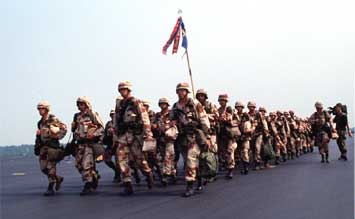



A U.N. ultimatum, Security Council
Resolution 678, followed on November 29, 1990. It stipulated that if Iraqi dictator Saddam Hussein did not remove his troops
from Kuwait by January 15, 1991 a U.S.-led coalition was authorized to drive them out. Early in the morning of January 17,
Baghdad time, the U.S.-led coalition launched air attacks against Iraqi targets. On February 24, coalition ground forces begin
their attack. On February 27, Kuwait City was declared liberated, and with allied forces having driven well into Iraq, President
Bush and his advisers decided to halt the war. A cease-fire took effect at 8:00 the following morning.


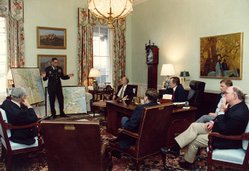

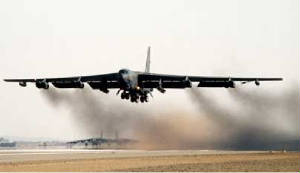
On the morning of January 16, Allied forces began the first
phase of Operation Desert Storm: the attack on Iraq. American forces systematically destroyed first the Iraqi border radar
stations; then other key elements of the Iraqi anti-aircraft network; and finally began bombing key targets in downtown Iraq,
including the Presidential palace, communication centers and power stations. The Allied forces lost only 2 planes during the
attacks. The attacks continued day and night.


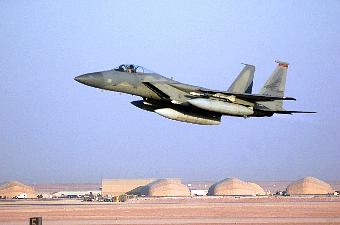

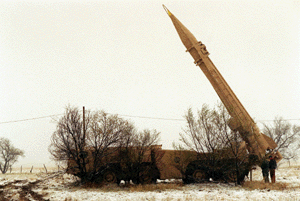

On January 17, at 3 AM, the Iraqis fired seven Scud missiles at Israel.
Israelis, based on Saddam's earlier threats to burn half of Israel with chemical weapons, awaited the missiles wearing gas
masks. The Scuds only had conventional warheads, but their terror value was immense. The Israelis, following their long-stated
doctrine, wanted to retaliate massively immediately. However Washington heavily pressured Jerusalem not to respond. To convince
Israel not to respond to the Scud attacks that continued, the US promised to increase the number of aircraft sorties aimed
at Scud sites. It also rushed Israel Patriot missile systems, with American crews, that had been modified to intercept incoming
Scuds.


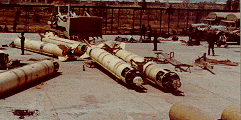
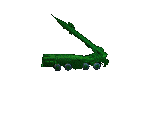



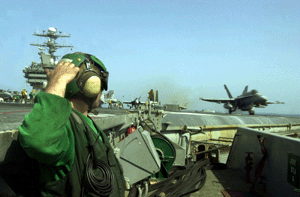
Those initial air attacks
constituted the first time the American military witnessed how their new arsenal performed in combat conditions. With such
ground systems as the M1A1 Abrams missile and the MIM-104 Patriot missile, the Iraq military had little opportunity to defend
themselves. Also, such other groundbreaking technology as the Global Positioning System (GPS), helped to pinpoint hits by
the Tomahawk missile and other weapons.
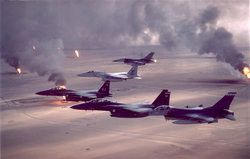
The damage done by U.S. air attacks was devastating to Saddam's vaunted
Republican Guard. The following U.S. aircraft left "a big hurt" on the enemy during the war: AH-64 Apache helicopters, B-52
Stratofortress bombers, E-3 AWACS surveillance aircraft, F-117A Stealth fighters, E-8C JSTARS radar command posts, and the
RPVs (drones


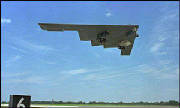


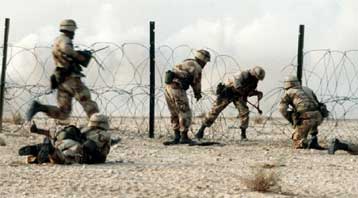
After thirty-eight days of continuous air attacks on targets
in Iraq and Kuwait, President George H. Bush directed Central Command to proceed with the ground offensive. General Schwarzkopf
unleashed all-out attacks against Iraqi forces very early on 24 February at three points along the allied line. In the far
west the French 6th Light Armored and the 101st Airborne Divisions started the massive western envelopment with a ground assault
to secure the allied left flank and an air assault to establish forward support bases deep in Iraqi territory. In the approximate
center of the allied line, along the Wadi al Batin.


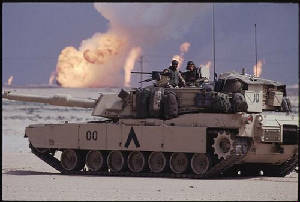
"We are not intimidated by the size of the armies,
or the type of hardware the US has brought."
Saddam Hussein
November 12, 1990





Maj. Gen. John H. Tilelli Jr.'s 1st Cavalry Division attacked north into a concentration
of Iraqi divisions, whose commanders remained convinced that the coalition would use that and several other wadies as avenues
of attack. In the east two Marine divisions, with the Army's Tiger Brigade, and coalition forces under Saudi command attacked
north into Kuwait. Faced with major attacks from three widely separated points, the Iraqi command had to begin its ground
defense of Kuwait and the homeland by dispersing its combat power and logistical capability.

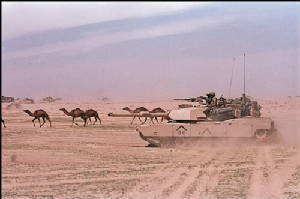
On the evening of January 29, after two weeks of air assaults,
the Iraqis mounted their one attack. The Iraqi 5th Mechanized Division attacked southward, capturing the Saudi town of Al
Khafji, eight miles south of the Kuwaiti border. The Iraqis repulsed the first Saudi force that attempted a counterattack
and, despite massive American air attacks, they held on to the town through the day and night. The next day, however, the
Saudis recaptured the town, forcing the remaining Iraqis to flee back to the Kuwaiti border.




Ground Attack Day 1
On February 24, at 4 AM, led by
the Marines, the Allied troops crossed the borders into Kuwait. For the days before the attack, the Iraqi troops had been
subjected to merciless air attacks; every possible target was struck. The Allied offensive had three major prongs: the first
aimed at Kuwait City, the second to the west aimed at the Iraqi flanks, and the final one far to the west, beyond the major
Iraqi lines that would totally outflank Iraqi lines. In the first day of the war, all the major objectives were reached, with
the Marines advancing halfway to Kuwait City and the western advances proceeding without difficulty. American casualties in
the first day of fighting were incredibly light.


Ground Attack Day 2
On the second day of the war, the
American troops advanced further on all fronts. The Marines approached Kuwait City, while the west prongs began to cut off
the Iraqis' ability to withdraw. Once again, American casualties were extremely low.


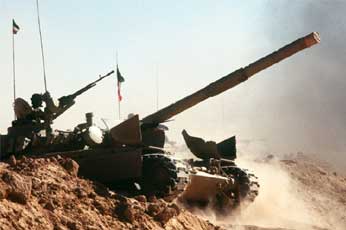



Ground Attack Day 3
The third day of the war saw the
largest tank battle in history. The American armored forces engaged the tank forces of the Republican guard. The American
tanks completely destroyed the Iraqi heavy armor without losing a single tank. During the third day, the Iraqi army began
a headlong retreat from Kuwait and southern Iraq. That retreat was cut off by Allied aircraft. Iraqis were told to leave their
vehicles and retreat by foot. Their vehicles were destroyed from the air. That night, Allied troops liberated Kuwait City.

Ground Attack Day 4: The End
The fourth and last full day of
the war saw the American forces continuing the destruction of much of the Iraqi Army. A decision had already been taken in
Washington to end the war at 100 hours. It had been determined that an assault on Baghdad was impractical, and thus the best
that could be done was to destroy as much Iraqi equipment as possible, and that was what was done in the last hours of the
war.


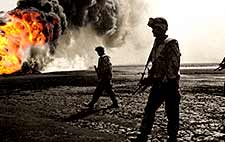


The U.N. coalition's forces included
troops and equipment from Great Britain, France, Saudi Arabia, Syria, Egypt, Canada, Italy, Oman, Qatar, and the United Arab
Emirates. For its part the United States provided 527,000 troops, 110 naval vessels, 2,000 tanks, 1,800 fixed-wing aircraft,
and 1,700 helicopters. Losses incurred on the way to the swift victory were remarkably one-sided: "Iraqi military casualties
totaled an estimated 25,000 to 65,000....In contrast, UN forces suffered combat losses of some 200 personnel from hostile
fire." One hundred twenty-two Americans died from hostile fire, while thirty-five were lost to friendly fire. There were also
one hundred thirty-one non-combat fatalities among the American contingent.


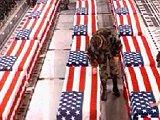

It can be clearly said that due to the extreme power and
sophistication of the U.S. and her allies that Saddam and his tiny nation of 17 million people stood no chance against the
military might that is the United States and its Allies.


U.S. Casualties: 147 battle deaths, 145 non-battle
deaths, 1 missing in action
Army: 98 battle; 105 non-battle
Navy 5 battle; 8 non-battle; 1 missing
in action
Marines: 24 battle; 26 non-battle
Air Force: 20 battle; 6 non-battle
Women killed, 15
Wounded in action: 467.




Iraqi Casualties
Of Iraq's 545,000 troops in the Kuwait
theater of operations, an estimated 100,000 were killed, and 300,000 were wounded.

The war in the Persian Gulf was a war of religious fervor,
and cruel leadership. Desert Storm was the same type of war that had occurred in this area for many years except for one fact.
In Operation Desert Storm, sophisticated technology was used to end the war in a quick and timely manner.


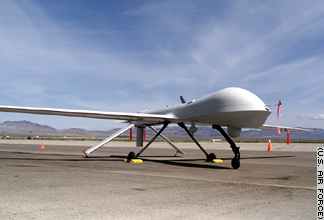

I believe the magnificent performance of
our forces and the totality of their victory have clearly established the tenor of after-action discussions--success. We planned,
mobilized, deployed, and executed this operation farther from the shores of the continental United States than ever before.
We applied military pawer beyond what our coalition partners--and indeed many Americans--could have imagined. Our accomplishments
and successes greatly overshadow any identified shortfalls or deficiencies." General
H. Norman Schwarzkopf, USA Commander-in-Chief U.S. Central Command


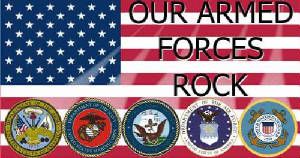



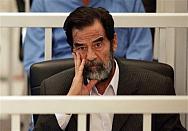
I led my country
in confrontation by an aggression launched by 33 countries led by U.S., which waged war against Iraq, the Iraqis' confrontation
of which is called by Arabs and Iraqis as the Battle of Battles (Um Al-Ma’arik), where Iraq stood fast against the invasion,
maintaining its sovereignty and political system.
Saddam Hussein's journal.
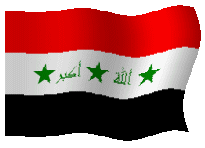




Southwest Asia Service 1991-1995
This medal was authorized on 12
March 1991 for participation in or support of military operations in Southwest Asia or in the surrounding areas between 2
August 1990 and 30 November 1995, including Operations Desert Shield and Desert Storm.
3 Bronze Stars
1. Defense of Saudi Arabia (02
Aug 1990 - 16 Jan 1991)
2. Liberation and Defense of Kuwait (17 Jan 1991 - 11 Apr 1991)
3. Southwest Asia Ceasefire
Campaign (12 Apr 1991 - 30 Nov 1995)


|
Gulf War (1990-1991) |
|
|
Total Servicemembers (Worldwide) |
2,322,332 |
|
Deployed to Gulf |
1,136,658 |
|
Battle Deaths |
148 |
|
Other Deaths (In Theater) |
235 |
|
Other Deaths in Service (Non-Theater) |
914 |
|
Non-mortal Woundings |
467 |
|
Living Veteran |
1,753,530 |


The art of war is simple enough. Find out
where your enemy is. Get at him as soon
as
you can. Strike him as hard as you can and
as often as you can, and keep moving on.
Ulysses S. Grant

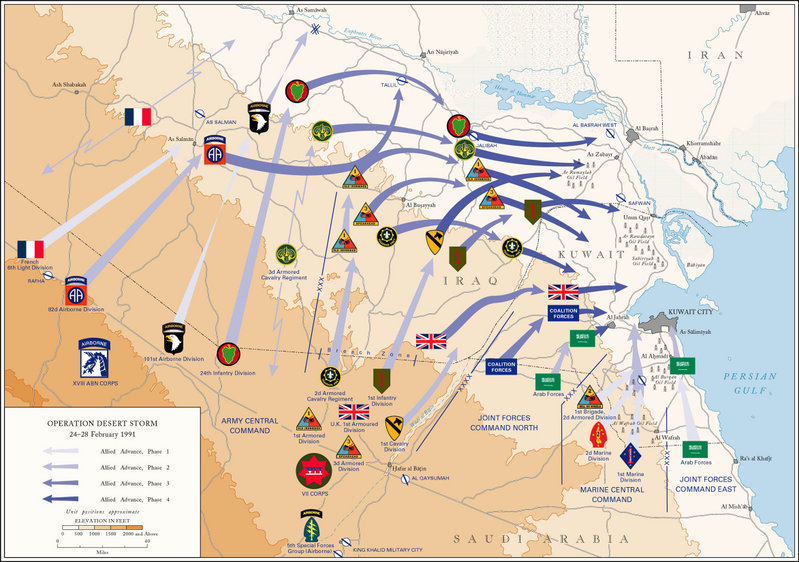


|

